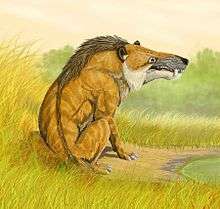Cetancodontamorpha
| Cetacodontamorpha Temporal range: Early Eocene to present | |
|---|---|
 | |
| Andrewsarchus | |
| Scientific classification | |
| Kingdom: | Animalia |
| Phylum: | Chordata |
| Clade: | Synapsida |
| Class: | Mammalia |
| Order: | Artiodactyla |
| Clade: | Cetruminantia |
| Clade: | Cetancodontamorpha Spaulding et al., 2009 |
| Genera and Clades | |
|
†Siamotherium | |
Cetancodontamorpha is a total clade of artiodactyls[1] defined, according to Spaulding et al., as Whippomorpha "plus all extinct taxa more closely related to extant members of [Whippomorpha] than to any other living species".[2] Attempts have been made to rename the clade Whippomorpha to Cetancodonta, but the former maintains precedent.[3]
Whippomorpha is the crown clade containing Cetacea (whales, dolphins, etc.) and hippopotamuses.[4] According to Spaulding et al., members of the whippomorph stem group (i.e., "stem-whippomorphs") include such taxa as the family Entelodontidae and the genus Andrewsarchus.
References
- ↑ "Archived copy". Archived from the original on 2012-05-16. Retrieved 2015-02-24.
- ↑ "Relationships of Cetacea (Artiodactyla) among mammals: increased taxon sampling alters interpretations of key fossils and character evolution". PLoS ONE. 4 (9): e7062. 2009. PMC 2740860
 . PMID 19774069. doi:10.1371/journal.pone.0007062.
. PMID 19774069. doi:10.1371/journal.pone.0007062. - ↑ Asher, Robert J.; Helgen, Kristofer M. (2010). "Nomenclature and placental mammal phylogeny". BMC Evolutionary Biology. 10: 102. PMC 2865478
 . PMID 20406454. doi:10.1186/1471-2148-10-102.
. PMID 20406454. doi:10.1186/1471-2148-10-102. - ↑ A higher-level MRP supertree of placental mammals
This article is issued from
Wikipedia.
The text is licensed under Creative Commons - Attribution - Sharealike.
Additional terms may apply for the media files.